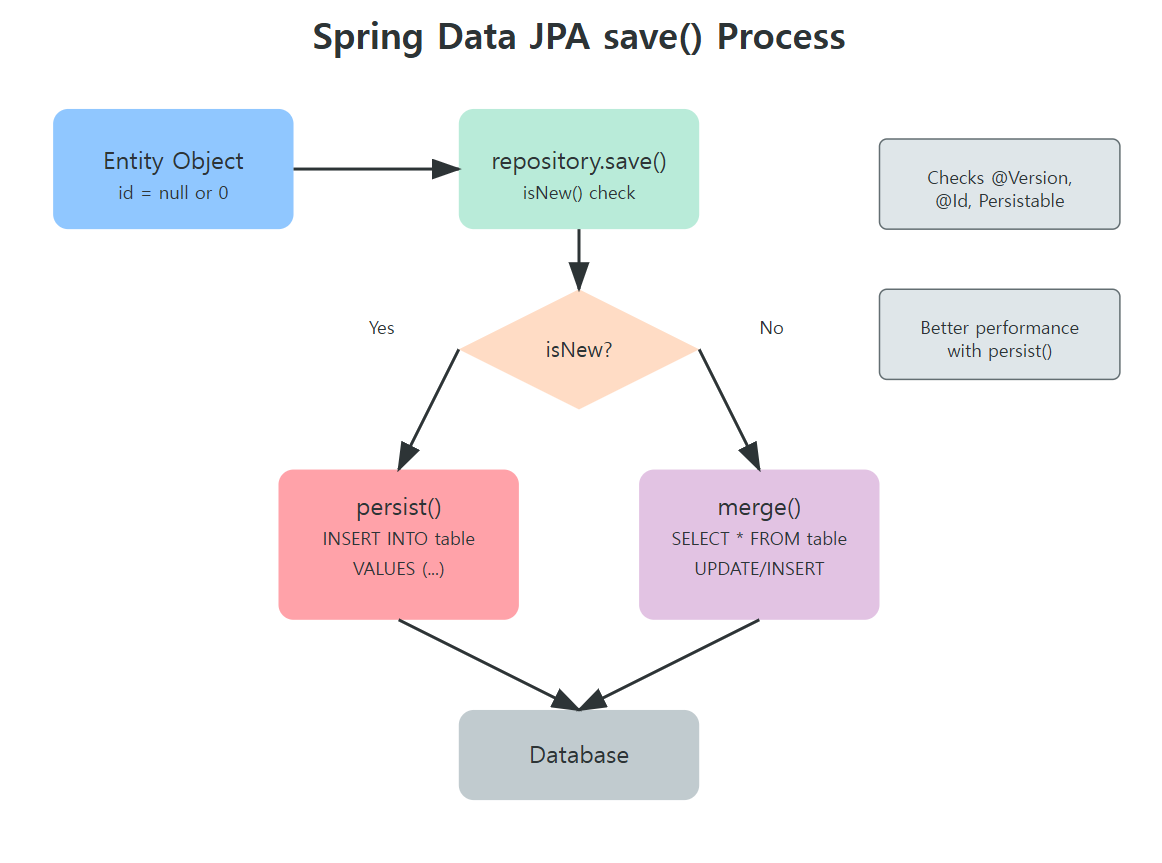[Backend] Spring Data JPA에서 새로운 Entity 판단하기
[Backend] Spring Data JPA에서 새로운 Entity 판단하기
들어가며
Spring Data JPA를 사용하다 보면 save() 메서드 하나로 새로운 엔티티의 저장과 기존 엔티티의 수정을 모두 처리할 수 있어 편리합니다. 하지만 이 과정에서 Spring Data JPA는 어떻게 새로운 엔티티인지 아닌지를 판단할까요? 이번 글에서는 이 판단 과정을 상세히 살펴보고, 실제 개발 시 주의해야 할 점들을 알아보겠습니다.
새로운 Entity 판단의 기본 원리
1. @Version 기반 판단
Spring Data JPA는 먼저 엔티티에 @Version 애노테이션이 있는지 확인합니다:
1
2
3
4
5
6
7
8
9
10
11
12
@Entity
public class Product {
@Id
@GeneratedValue(strategy = GenerationType.IDENTITY)
private Long id;
@Version
private Long version;
private String name;
private int price;
}
이런 경우 판단 로직은 다음과 같이 동작합니다:
1
2
3
4
5
6
7
8
9
10
11
12
13
@Override
public boolean isNew(T entity) {
if(versionAttribute.isEmpty()
|| versionAttribute.map(Attribute::getJavaType)
.map(Class::isPrimitive)
.orElse(false)) {
return super.isNew(entity);
}
BeanWrapper wrapper = new DirectFieldAccessFallbackBeanWrapper(entity);
return versionAttribute.map(it -> wrapper.getPropertyValue(it.getName()) == null)
.orElse(true);
}
- Wrapper 클래스(Long, Integer 등)인 경우: null이면 새로운 엔티티로 판단
- Primitive 타입(long, int 등)인 경우: 상위 클래스의 판단 로직 사용
2. @Id 기반 판단
@Version이 없거나 primitive 타입인 경우, @Id 필드를 기준으로 판단합니다:
1
2
3
4
5
6
7
8
9
10
11
12
13
14
15
16
public boolean isNew(T entity) {
Id id = getId(entity);
Class<ID> idType = getIdType();
if (!idType.isPrimitive()) {
return id == null; // null이면 새로운 엔티티
}
if (id instanceof Number) {
return ((Number) id).longValue() == 0L; // 0이면 새로운 엔티티
}
throw new IllegalArgumentException(
String.format("Unsupported primitive id type %s", idType)
);
}
실제 사용 예시와 주의점
1. @GeneratedValue 사용 시
1
2
3
4
5
6
7
8
9
@Entity
public class User {
@Id
@GeneratedValue(strategy = GenerationType.IDENTITY)
private Long id;
private String name;
// 생성자, getter, setter 생략
}
1
2
3
4
5
6
7
8
9
10
11
12
13
14
15
16
17
@Service
@Transactional
public class UserService {
private final UserRepository userRepository;
public User createUser(String name) {
User user = new User();
user.setName(name);
return userRepository.save(user); // id가 null이므로 persist 실행
}
public User updateUser(Long id, String name) {
User user = userRepository.findById(id).orElseThrow();
user.setName(name);
return userRepository.save(user); // id가 존재하므로 merge 실행
}
}
2. ID 직접 할당 시의 문제점
1
2
3
4
5
6
@Entity
public class Document {
@Id // @GeneratedValue 사용하지 않음
private String documentId; // 업무 규칙에 따라 직접 ID 생성
private String content;
}
1
2
3
4
5
6
7
8
9
10
11
12
@Service
public class DocumentService {
public Document createDocument(String documentId, String content) {
Document doc = new Document();
doc.setDocumentId(documentId);
doc.setContent(content);
// 문제 발생! ID가 이미 존재하므로 merge가 실행됨
// 불필요한 select 쿼리가 발생
return documentRepository.save(doc);
}
}
3. Persistable 인터페이스를 통한 해결
1
2
3
4
5
6
7
8
9
10
11
12
13
14
15
16
17
18
19
20
21
@Entity
@EntityListeners(AuditingEntityListener.class)
public class Document implements Persistable<String> {
@Id
private String documentId;
private String content;
@CreatedDate
private LocalDateTime createdDate;
@Override
public String getId() {
return documentId;
}
@Override
public boolean isNew() {
// createdDate가 null이면 새로운 엔티티로 판단
return createdDate == null;
}
}
1
2
3
4
5
@Configuration
@EnableJpaAuditing
public class JpaConfig {
// JPA Auditing 활성화
}
실제 동작 과정 살펴보기
SimpleJpaRepository의 save() 메서드에서 isNew() 판단에 따라 다음과 같이 동작합니다:
1
2
3
4
5
6
7
8
9
10
11
12
@Override
@Transactional
public <S extends T> S save(S entity) {
Assert.notNull(entity, "Entity must not be null");
if (entityInformation.isNew(entity)) {
entityManager.persist(entity);
return entity;
} else {
return entityManager.merge(entity);
}
}
persist vs merge 동작 차이
- persist 동작:
1
insert into document (document_id, content) values (?, ?)
- merge 동작:
1 2 3 4
-- 먼저 select 쿼리 실행 select d.* from document d where d.document_id = ? -- 이후 insert 또는 update 실행 insert into document (document_id, content) values (?, ?)
성능 비교
예를 들어 1000개의 새로운 문서를 저장하는 경우:
- 일반적인 방식:
- 1000번의 select 쿼리
- 1000번의 insert 쿼리
- 총 2000번의 데이터베이스 작업
- Persistable 구현 시:
- 1000번의 insert 쿼리만 실행
- 50% 성능 향상
실무 적용 가이드
@GeneratedValue를 사용하는 경우:- 기본 동작을 그대로 사용
- ID를 직접 할당하는 경우:
Persistable인터페이스 구현@CreatedDate와 같은 감사(Auditing) 필드 활용- 별도의 필드로 신규 여부 관리
- 복합키(IdClass, EmbeddedId)를 사용하는 경우:
- 반드시
Persistable구현 검토
- 반드시
결론
Spring Data JPA의 새로운 엔티티 판단 로직은 기본적으로 잘 동작하지만, ID를 직접 할당하는 경우에는 주의가 필요합니다. Persistable 인터페이스를 구현하여 명시적으로 새로운 엔티티임을 알려주면, 불필요한 데이터베이스 조회를 방지하고 애플리케이션의 성능을 크게 향상시킬 수 있습니다.
참고문헌
이 글이 Spring Data JPA를 사용하면서 겪을 수 있는 성능 문제를 해결하는 데 도움이 되길 바랍니다.
이 기사는 저작권자의 CC BY 4.0 라이센스를 따릅니다.
